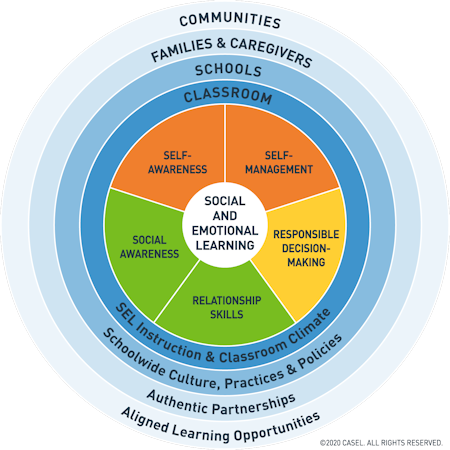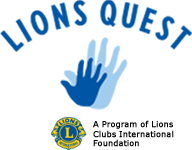Lions Quest and Social and Emotional Learning (SEL)
Find and share resources for creating a healthy school climate by helping students develop skills to manage their emotions, resolve conflicts, and make responsible decisions.
Social and Emotional Learning: The Foundation for Success in School and Life
Find out more about the Five Core Competencies of SEL developed by the Collaborative for Academic, Social, and Emotional Learning (CASEL).
Social and Emotional Learning and Bullying Prevention
Lions Quest uses and array of school, family, and community elements to address the most pervasive form of school violence – bullying.
Social and Emotional Learning and School-Family-Community Partnerships
Social and emotional learning starts at home and Lions Quest engages family and community members so that opportunities for skill development are continuously available.

Source: ©2020 CASEL. All Rights Reserved. [https://casel.org/what-is-sel/]
Social-Awareness
Social awareness: The abilities to understand the perspectives of and empathize with others, including those from diverse backgrounds, cultures, and contexts. This includes the capacities to feel compassion for others, understand broader historical and social norms for behavior in different settings, and recognize family, school, and community resources and supports.
Such as:
- Taking others’ perspectives
- Recognizing strengths in others
- Demonstrating empathy and compassion
- Showing concern for the feelings of others
- Understanding and expressing gratitude
- Identifying diverse social norms, including unjust ones
- Recognizing situational demands and opportunities
- Understanding the influences of organizations and systems on behavior
Check out this video (PBS Learning Media)
Self-Awareness
Self-awareness: The abilities to understand one’s own emotions, thoughts, and values and how they influence behavior across contexts. This includes capacities to recognize one’s strengths and limitations with a well-grounded sense of confidence and purpose.
Such as:
- Integrating personal and social identities
- Identifying personal, cultural, and linguistic assets
- Identifying one’s emotions
- Demonstrating honesty and integrity
- Linking feelings, values, and thoughts
- Examining prejudices and biases
- Experiencing self-efficacy
- Having a growth mindset
- Developing interests and a sense of purpose
Check out this video (PBS Learning Media)
Self-Management
Self-management: The abilities to manage one’s emotions, thoughts, and behaviors effectively in different situations and to achieve goals and aspirations. This includes the capacities to delay gratification, manage stress, and feel motivation and agency to accomplish personal and collective goals.
Such as:
- Managing one’s emotions
- Identifying and using stress management strategies
- Exhibiting self-discipline and self-motivation
- Setting personal and collective goals
- Using planning and organizational skills
- Showing the courage to take initiative
- Demonstrating personal and collective agency
Check out this video (PBS Learning Media)
Responsible Decision-making
Responsible decision-making: The abilities to make caring and constructive choices about personal behavior and social interactions across diverse situations. This includes the capacities to consider ethical standards and safety concerns, and to evaluate the benefits and consequences of various actions for personal, social, and collective well-being.
Such as:
- Demonstrating curiosity and open-mindedness
- Learning how to make a reasoned judgment after analyzing information, data, and facts
- Identifying solutions for personal and social problems
- Anticipating and evaluating the consequences of one’s actions
- Recognizing how critical thinking skills are useful both inside and outside of school
- Reflecting on one’s role to promote personal, family, and community well-being
- Evaluating personal, interpersonal, community, and institutional impacts
Check out this video (PBS Learning Media)
Relationship Skills
Relationship skills: The abilities to establish and maintain healthy and supportive relationships and to effectively navigate settings with diverse individuals and groups. This includes the capacities to communicate clearly, listen actively, cooperate, work collaboratively to problem solve and negotiate conflict constructively, navigate settings with differing social and cultural demands and opportunities, provide leadership, and seek or offer help when needed.
Such as:
- Communicating effectively
- Developing positive relationships
- Demonstrating cultural competency
- Practicing teamwork and collaborative problem-solving
- Resolving conflicts constructively
- Resisting negative social pressure
- Showing leadership in groups
- Seeking or offering support and help when needed
- Standing up for the rights of others
Check out this video (PBS Learning Media)
Classrooms
Effectively integrating SEL schoolwide involves ongoing planning, implementation, evaluation, and continuous improvement by all members of the school community. SEL efforts both contribute to and depend upon a school climate where all students and adults feel respected, supported, and engaged.
Because the school setting includes many contexts—classrooms, hallways, cafeteria, playground, bus—fostering a healthy school climate and culture requires active engagement from all adults and students. A strong school culture is rooted in students’ sense of belonging, with evidence that suggests that it plays a crucial role in students’ engagement. SEL also offers an opportunity to enhance existing systems of student support by integrating SEL goals and practices with universal, targeted, and intensive academic and behavioral supports. By coordinating and building upon SEL practices and programs, schools can create an environment that infuses SEL into every part of students’ educational experience and promotes positive social, emotional, and academic outcomes for all students.
Schools
Effectively integrating SEL school-wide involves ongoing planning, implementation, evaluation, and continuous improvement by all members of the school community. SEL efforts both contribute to and depend upon a school climate where all students and adults feel respected, supported, and engaged.
Because the school setting includes many contexts—classrooms, hallways, cafeteria, playground, bus—fostering a healthy school climate and culture requires active engagement from all adults and students. A strong school culture is rooted in students’ sense of belonging, with evidence that suggests that it plays a crucial role in students’ engagement. SEL also offers an opportunity to enhance existing systems of student support by integrating SEL goals and practices with universal, targeted, and intensive academic and behavioral supports. By coordinating and building upon SEL practices and programs, schools can create an environment that infuses SEL into every part of students’ educational experience and promotes positive social, emotional, and academic outcomes for all students.
Families & Caregivers
When schools and families form authentic partnerships, they can build strong connections that reinforce students’ social and emotional development. Families and caregivers are children’s first teachers, and bring deep expertise about their development, experiences, culture, and learning needs. These insights and perspectives are critical to informing, supporting, and sustaining SEL efforts. Research suggests that evidence-based SEL programs are more effective when they extend into the home, and families are far more likely to form partnerships with schools when their schools’ norms, values, and cultural representations reflect their own experiences. Schools need inclusive decision-making processes that ensure that families—particularly those from historically marginalized groups—are part of planning, implementing, and continuously improving SEL.
Schools can also create other avenues for family partnership that may include creating ongoing two-way communication with families, helping caregivers understand child development, helping teachers understand family backgrounds and cultures, providing opportunities for families to volunteer in schools, extending learning activities and discussions into homes, and coordinating family services with community partners. These efforts should engage families in understanding, experiencing, informing, and supporting the social and emotional development of their students.
Communities
Community partners often provide safe and developmentally rich settings for learning and development, have deep understanding of community needs and assets, are seen as trusted partners by families and students, and have connections to additional supports and services that school and families need. Community programs also offer opportunities for young people to practice their social and emotional skills in settings that are both personally relevant and can open opportunities for their future. To integrate SEL efforts across the school day and out-of-school time, school staff and community partners should align on common language and coordinate strategies and communication around SEL-related efforts and initiatives.
